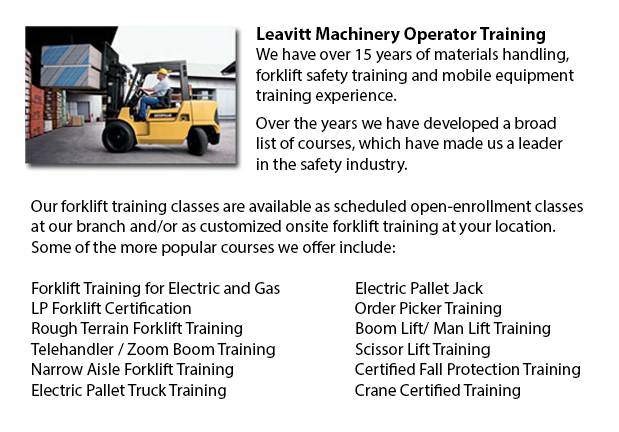
Forklift Training Programs Vancouver - If you are searching for work as a forklift operator, our regulatory-compliant lift truck training programs provide excellent instruction in numerous styles and types of lift trucks, classes on pre-shift check, fuel kinds and handling of fuels, and safe use of a forklift. Hands-on, practical training assists participants in obtaining essential operational skills. Program content includes current rules governing the use of forklifts. Our proven forklift courses are designed to provide training on these types of trucks: counterbalanced forklift, powered pallet trucks and narrow isle forklift.
How to Safely Handle Loads
Do not lower or raise the fork while the forklift is traveling. A load must not extend higher than the backrest due to the danger of the load sliding back toward the operator. Check for overhead obstructions and ensure there is sufficient clearance prior to raising a load. Stay away from overhead power lines. When the load is lifted straight up, tilt it slightly back.
When the load is lifted the forklift will be less stable. Make sure that no pedestrians cross beneath the elevated fork. The operator must not leave the lift truck when the load is raised.
While handling pallets, forks should be high and level enough to go into the pallet and extend all the way beneath the load. The fork's width should provide even distribution of weight.
Before loading or unloading the truck, chock the wheels and set the brakes. Floors need to be strong enough to support the weight of the forklift and the load combined. Fixed jacks could be installed to be able to support a semi-trailer that is not coupled to a tractor. The entrance door height must clear the height of the forklift by a minimum of 5 cm. Mark edges of docks, rail cars or ramps and avoid them.
If there is not proper ventilation into the forklift, do not stay in there for extended periods. The interior of the truck should have adequate lighting and be obstruction free. Inspect the flooring of the forklift cab for holes. The installation of nonslip material on the floor will help avoid slipping. Clear whichever obstacles from dockplates and docks and ensure surfaces are not oily or wet.
Lift trucks should not be utilized to tow or push other forklifts.
-
Telehandler Ticket Vancouver
Telehandler Ticket Vancouver - The telescopic handler or telehandler is a frequently used equipment in agricultural and industrial applications. This equipment is similar in appearance to a forklift and also functions in a similar way, even if teleha... More -
Forklift Operator Certification Vancouver
Forklift Operator Certification Vancouver - Forklift operator certification is usually needed for employees working within industrial, warehouse or construction environments to guarantee the safe operation of forklifts. Workplace training need to fol... More -
Certified Fall Protection Training in Vancouver
There are high numbers of injuries at work linked to falling and a lot of fall-related deaths reported each and every year. The majority of these instances might have been avoided with better training, better measures in place, and by correctly equip... More -
Forklift Training Course Vancouver
Forklift Training Course Vancouver - CSA and OSHA establish criteria for forklift safety training which meets existing standards and regulations. Anyone planning to utilize a forklift is needed to successfully complete safety training prior to using... More -
Overhead Crane Certification Vancouver
Overhead Crane Certification Vancouver - The overhead crane certification course is a program that is designed to assist trainees, even if they have literacy or language restrictions. The course comprises a practical hands-on training session and a c... More -
Forklift Instructor Training Vancouver
Forklift Instructor Training Vancouver - Forklift Instructor training certification is recommended for forklift operators who would like to become instructors. To qualify for forklift instructor training, operators must be able to prove they possess... More -
Crane / Overhead Crane / Truck Mounted Crane / Hydraulic Cranes Training in Vancouver
Overhead cranes are likewise referred to as bridge cranes. They are actually a type of crane which comprises a hook and line apparatus which runs along a horizontal beam which runs along two widely separated rails. Lots of overhead cranes can be foun... More -
Scissor Lift Safety Training Vancouver
Scissor Lift Safety Training Vancouver - A scissor lift is a kind of platform lift that moves vertically. The lift table is moved in a vertical motion because of criss-cross folding supports which are linked in what is referred to as a pantograph. Th... More

Forklift Training Vancouver
TOLL FREE: 1-888-254-6157
24389 Fraser Highway
Langley, British Columbia
forklifttrainingvancouver.com
Email Us
About Us


